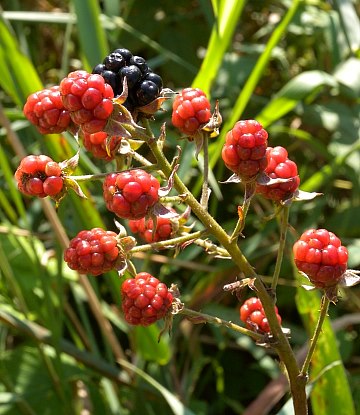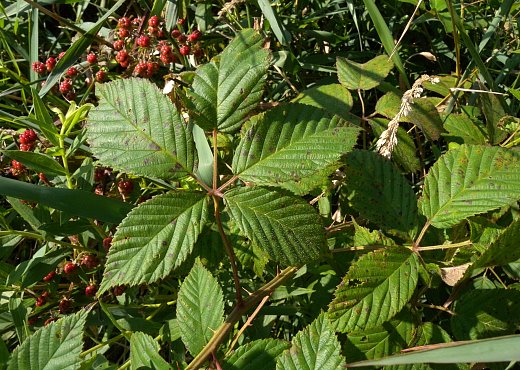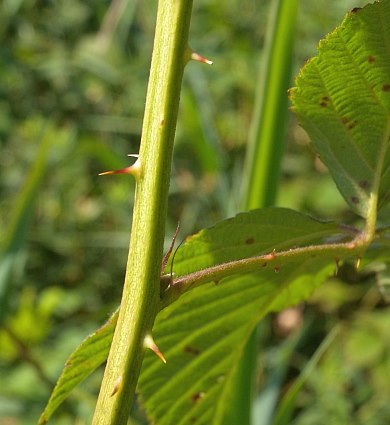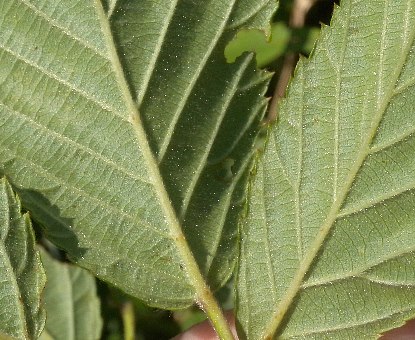
Second-year canes develop elongated racemes of 5-20 flowers about 2-6" long. The peduncle and pedicels of each raceme are light green to yellowish green and more or less covered with appressed woolly hairs that are white to pale brown; these hairs are non-glandular. The pedicels are ascending to widely spreading. The leafy bracts of each raceme are small, inconspicuous, and deciduous. Individual flowers are about ¾-1" across, consisting of 5 white petals, 5 light green sepals, a greenish compound pistil with multiple styles, and a ring of many stamens. The widely spreading petals are oblong to elliptic in shape, while the sepals are lanceolate, recurved, and densely covered with appressed white hairs. The blooming period occurs during the late spring and lasts about 3 weeks. During the summer, the flowers are replaced by fruits that are compound drupes. At maturity, these compound drupes change from bright red to black; they are about 1/3-2/3" (8-16 mm.) in length and globoid to ovoid in shape. Each drupelet of a drupe contains a single yellow seed. Mature drupes are juicy and vary in flavor from sour to sweet-tart. Second-year canes die down after bearing fruits, but they are replaced by new canes from underground runners.

Cultivation: The preference is full or partial sun, moist to dry-mesic conditions, and soil containing loam, silt, sand, or gravel. At drier sites, this blackberry does better when it receives some protection from the afternoon sun.
Range & Habitat: The native Highbush Blackberry is occasional to locally common in most areas of Illinois (see Distribution Map). It is less common in the northern section of the state than elsewhere because Illinois lies close to its northern range limit. Habitats include savannas and sandy savannas, thickets and sandy thickets, riverbottom prairies and moist sand prairies, woodland borders, and acidic gravelly seeps. This blackberry is usually found in areas where there has been some disturbance from natural or human-related causes. It is a pioneer species.

Faunal Associations: The nectar and pollen of the flowers attract a variety of insects, especially long-tongued and short-tongued bees. Other floral visitors include wasps, flies, butterflies, and skippers. Other insects feed on the foliage, bore through the canes, or use other parts of blackberries as a food source. These species include the caterpillars of Satyrium liparops strigosum (Striped Hairstreak); also the caterpillars of such moths as Chlorochlamys chloroleuca (Blackberry Looper Moth), Olethreutes permundana (Raspberry Leafroller), Pennisetia marginata (Raspberry Crown Borer), and others. Additional insect feeders include the larvae of Hartigia trimaculata (Rose Shoot Sawfly) and Metallus rohweri (Blackberry Leafminer); Trioza tripunctata (Blackberry Psyllid); the treehoppers Stictocephala albescens and Stictocephala taurina; Typhlocyba rosae (Rose Leafhopper), Erythroneura octonotata (Eight-Spotted Leafhopper), and other leafhoppers; the aphids Amphorophora sensoriata, Aphis rubicola, and Aphis rubifolii; the plant bug Dicyphus famelicus; the larvae of such wood-boring beetles as Agrilus ruficollis (Red-Necked Cane Borer) and Oberea bimaculata (Raspberry Cane Borer); the leaf beetles Neochlamisus eubati and Neochlamisus gibbosus; and Byturus unicolor (Raspberry Fruitworm Beetle). The Insect Table provides a more complete listing of these various insect species. The fruits of blackberries are an important source of food to many upland gamebirds and songbirds (see Bird Table), and they are also eaten by such mammals as the Black Bear, Gray Fox, Red Fox, Opossum, Raccoon, Striped Skunk, Fox Squirrel, Gray Squirrel, Red Squirrel, Eastern Chipmunk, White-Footed Mouse, Woodland Deer Mouse, and Jumping Mouse. Notwithstanding the prickles, both the Cottontail Rabbit and White-Tailed Deer occasionally browse on the foliage and tender first-year canes. Blackberry thickets also provide nesting habitat for various songbirds, including the Cardinal, Yellow-Breasted Chat, Indigo Bunting, and Field Sparrow. Such thickets also provide good protective cover for many birds, mammals, and other wildlife.

Photographic Location: A moist sand prairie at the Indiana Dunes National Lakeshore in NW Indiana.
Comments: Highbush Blackberry has a similar appearance to Rubus allegheniensis (Common Blackberry). Both of these species produce elongated racemes of flowers (or drupes) that have small and insignificant bracts. While the racemes of Highbush Blackberry have stalks with woolly non-glandular hairs, the racemes of Common Blackberry have stalks with sticky-glandular hairs. The drupes of Common Blackberry are usually longer (½-¾" ) than those of Highbush Blackberry, its leaflets are usually more broad in shape, and the petals of its flowers are slightly wider and tend to overlap. With the exception of the presence or absence of glandular hairs, these differences are more subtle than dramatic. Another common species, Rubus pensilvanicus (Leafy-Bracted Blackberry), produces its flowers (and drupes) in flat-headed corymbs that have large leafy bracts. As a result, its flowers and fruits are sometimes partially hidden by these bracts. In the Rubus genus, there has been excessive taxonomic splitting in the past. As a result, some older species of blackberry are now regarded as variants of current species of blackberry; Rubus ostryifolius and several others are considered scientific synonyms of Rubus argutus (Highbush Blackberry). Other common names of this species are Sawtooth Blackberry, Sharp-Toothed Blackberry, and Florida Prickly Blackberry.